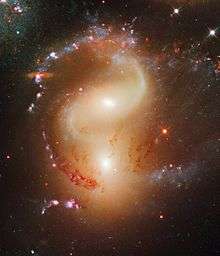NGC 7318
| NGC 7318 | |
|---|---|
 | |
| Observation data (J2000 epoch) | |
| Constellation | Pegasus |
| Right ascension | 22h 35m 56.7s / 22h 35m 58.4s |
| Declination | +33° 57′ 56″ / +33° 57′ 57″ |
| Redshift | 6630 ± 23 / 5774 ± 24 km/s |
| Distance | 300 Mly |
| Apparent magnitude (V) | 14.4 / 13.9 |
| Characteristics | |
| Type | E2 pec / SB(s)bc pec |
| Apparent size (V) | 0′.9 × 0′.9 / 1′.9 × 1′.2 |
| Notable features | Colliding galaxies |
| Other designations | |
|
References: [1] | |
NGC 7318 (also known as UGC 12099/UGC 12100 or HCG 92d/b) are a pair of colliding galaxies about 300 million light-years from Earth. They appear in the Constellation Pegasus and are members of the Stephan's Quintet.
The Spitzer Space Telescope revealed the presence of a huge intergalactic shock wave, shown by a green arc produced by one galaxy falling into another at millions of kilometers per hour. As NGC 7318B collides with NGC 7318A, gas spread throughout the cluster, atoms of hydrogen are heated in the shock wave, producing the green glow. The molecular hydrogen visible in the collision is one of the most turbulent forms known. This phenomenon was discovered by an international team of scientists of the Max Planck Institute for Nuclear Physics (MPIK) in Heidelberg. This collision can help provide a view into what happened in the early universe, around 10 billion years ago.
External links
- Hickson 92 in Pegasus
- SIMBAD: VV 288 -- Interacting Galaxies
- SIMBAD: UGC 12100—Interacting Galaxies
References
- ↑ "NASA/IPAC Extragalactic Database". Results for NGC 7318a / 7318b. Retrieved 2006-10-23.
Coordinates: ![]() 22h 35m 56.7s, +33° 57′ 56″
22h 35m 56.7s, +33° 57′ 56″